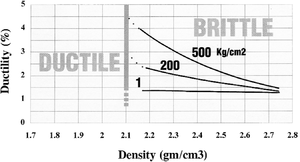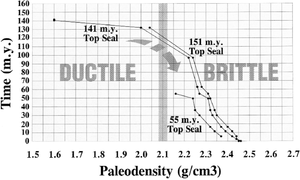Top seal ductility estimation
| Exploring for Oil and Gas Traps | |

| |
| Series | Treatise in Petroleum Geology |
|---|---|
| Part | Predicting the occurrence of oil and gas traps |
| Chapter | Evaluating top and fault seal |
| Author | Grant M. Skerlec |
| Link | Web page |
| Store | AAPG Store |
The ductility of a top seal can be estimated (1) by using laboratory data and log-derived density values that reflect the compaction state or (2) by comparing the strains in tested traps associated with successes and failures.
Shale ductility and density

The ductility of a shale top seal is a function of compaction state. Uncompacted, low-density shales are extremely ductile and can thus accommodate large amounts of strain without undergoing brittle failure and loss of top seal integrity. Highly compacted, dense shales are extremely brittle and undergo brittle failure and loss of top seal integrity with very small amounts of strain.
The following figure shows the relationship between ductility and density for 68 shales. The ductility of the shales was measured in the laboratory at confining pressures of 1, 200, and 500 kg/cm2. All samples were deformed in compression.
Figure 1 illustrates the following:
- Shales with a density less than approximately 2.1 g/cm3 deform ductilely and not by brittle failure at the range of confining pressures found in most sedimentary basins.
- Shales with a density greater than 2.1 g/cm3 will undergo brittle failure given sufficient strain.
- The ductility can be inferred from the density. Denser shales are more brittle and can withstand less strain before fracturing. Less-dense shales are more ductile and can withstand larger strains before fracturing.
- Ductility increases with increasing confining pressure.
Use in other lithologies
This technique has been used on other seal lithologies besides shales, including siltstones, marls, and chalks.[2] There is no relationship between the density and the ductility of sandstones where high permeability and diagenetic effects alter the more simple relationship observed in less permeable rocks.
Shale ductility vs. depth
The ductility of a shale top seal decreases with progressive burial, compaction, and diagenesis within a sedimentary basin. The mechanical properties are not constant but change with progressive burial as the top seal is converted from a mud to a rock.
The ductility of a shale top seal also increases in response to increasing confining pressure. Thus, a shale with constant mechanical properties will have a lower ductility at shallow depths than at greater depth. Since a shale top seal does not have constant mechanical properties with progressive burial, compaction decreases ductility at the same time as confining pressure increases ductility.
Shale density-ductility vs. depth

Figure 2 shows the change in density and ductility of shales with increasing depth. Laboratory data are plotted on a normal shale compaction curve showing density vs. depth. The figure shows the ductility of each shale at that depth or confining pressure, with ductile samples shown by gray circles and brittle samples shown by black circles. Ductile shales did not fracture; brittle shales fractured. A low-density shale at a depth of length::500 m is more ductile than a highly compacted shale at a depth of depth::5000 m in the center of the basin. Identical traps, one in the graben deep and one on an adjacent marginal platform, have different seal risk.
Ductility vs. time
Ductility changes not only with depth of burial but also with time and progressive subsidence. A shale top seal now buried at depth::4000 m and having a density of 2.6 g/cm3 was once buried at a more shallow depth and had a lower density. This now-brittle seal was once ductile.
Predicting paleoductility
To predict paleoductility, we must know both the density and the confining pressure at the time of deformation. A database of top seal mechanical properties over a range of pertinent confining pressures is a basic tool for seal analysis.
Ductility-time plots
Ductility-time plots can be constructed from shale compaction curves and burial history curves. Burial history curves give the depth of burial of a top seal at a specific time. Shale compaction curves let us infer the shale density at a specific depth of burial and time.
Figure 3 is a ductility-time plot for an Upper Jurassic top seal in the Central Graben, North Sea. The plot shows the paleodensity and inferred paleoductility during progressive burial of shales at the 141- and 151-m.y sequence boundaries. Prior to approximately 100 m.y, the Late Jurassic shale top seal had a density of 3 and was ductile. Strain prior to length::100 m.y. would not contribute to seal risk. Any deformation occurring after length::100 m.y. could have caused fracturing, given sufficiently high strains.
See also
- Strain analysis of top seals
- Seal ductility
- Estimating strain in top seals
- Example: evaluating top seal integrity
References
- ↑ 1.0 1.1 Hoshino, K., Koide, H., Inami, K., Iwamura, S., Mitsui, S., 1972, Mechanical properties of Japanese Tertiary sedimentary rocks under high confining pressures: Geological Survey of Japan Report 244, 200 p.
- ↑ Skerlec, G., M., 1990, SEALS: A short course for risking top seal and fault seal: Franklin, Pennsylvania, SEALS International, 600 p.
